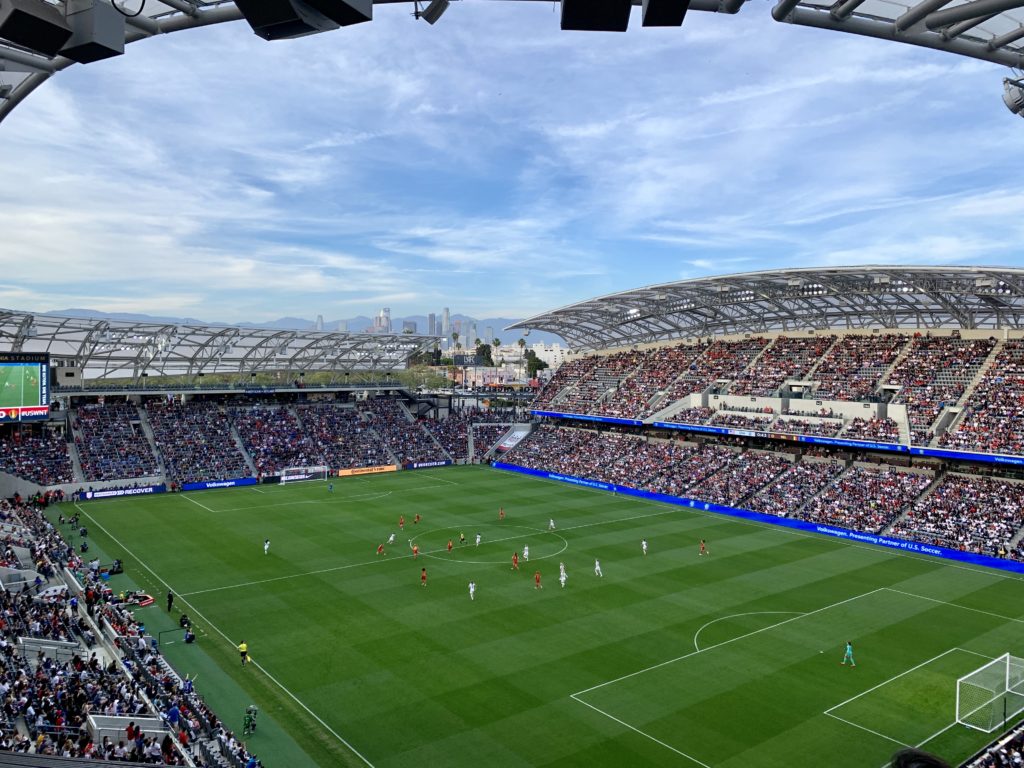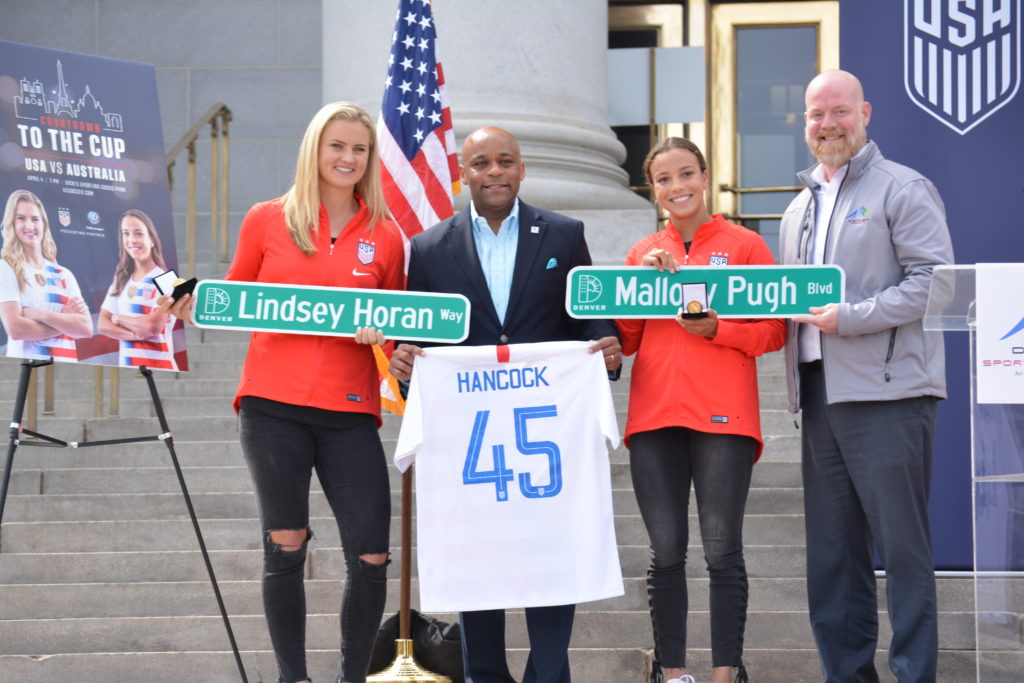A World of Opportunity
U.S. Soccer and the NWSL hope World Cup attention will help grow the sport
Posted On: May 22, 2019 By :Excitement is rising for the 2019 FIFA Women’s World Cup, which will be staged June 7–July 7 in nine cities in France. As of March, more than 500,000 tickets had been sold, 23 percent to ticket buyers in the United States—and there’s good reason for the strong American interest. The 2019 tournament will mark the eighth consecutive World Cup appearance for the U.S. Women’s National Team, which took home the trophy in 1991, 1999 and 2015.
While fan engagement has grown organically as a result of the national team’s success, other factors have also contributed to the rise in interest. For one, U.S. Soccer has been strategic in its efforts to build the fan base, highlight the players and invest in the National Women’s Soccer League, with the goal of elevating the status of women’s soccer and ensuring a sustainable league.
Picking the Right Cities
To create buzz for the World Cup, U.S. Soccer launched Countdown to the Cup, a 10-game series that brought the women’s national team to 10 different cities from January to May. The series kicked off with the United States playing France and Spain overseas. Then came the SheBelieves Cup, a three-game tournament against Japan, England and Brazil that was contested at Talen Energy Stadium in Chester, Pennsylvania; Nissan Stadium in Nashville; and Raymond James Stadium in Tampa, Florida. Next the players were off to Denver and Los Angeles for international friendlies with Australia and Belgium, respectively. The Countdown to the Cup concluded with the Send-Off Series, three games against South Africa, New Zealand and Mexico at Levi’s Stadium in Santa Clara, California; Busch Stadium in St. Louis; and Red Bull Arena in Harrison, New Jersey.
When it came to selecting the venues, the federation asked questions such as: Has the national team played there in the last year? Is there a new venue? What’s the availability of the venue? What is the weather like during that time of year? U.S. Soccer tries to schedule games 12 to 24 months out. “We tried to lock things in before the end of the year so we could promote all 10 of these games as a collective unit and drive as many fans to attend these matches as possible,” said Neil Buethe, chief communications officer for U.S. Soccer. “It’s really a touchpoint for as many fans across the country as possible to come and see this team and cheer on the players before they head off to France for the World Cup.”
Attendance has been high at these exhibition matches and “we’ve been really happy with the turnout of the games so far,” Buethe said. The women’s team defeated Australia in front of a sellout crowd at the 18,000-seat Dick’s Sporting Goods Park. Three days later, the team earned another victory, this time against Belgium at Banc of California Stadium, which hosted the women’s national team for the first time. Although it was not quite a sellout, 20,941 people showed up to watch the U.S. score six goals. In May, 35,761 turned out to watch the U.S. defeat New Zealand, 5-0.

Meanwhile, the NWSL—entering its seventh season—has also experienced growth in attendance, averaging more than 6,000 people per game last year, a record. “We’ve seen steady growth in attendance over the previous six seasons and certainly anticipate that to continue this season,” said Amanda Duffy, president of the NWSL. “We learned a lot in 2015, which was the first women’s World Cup year that the NWSL experienced. And the data supports that this will be a year where we’ll see an upward trend in attendance as a result of the visibility and engagement and support women’s soccer will see.”
Getting in Front of Fans
Although interest in the women’s game has increased in the past five years, U.S. Soccer knows there is still much work to be done when it comes to sustaining that growth. But if there is something that could help casual fans cross the bridge to becoming avid fans, it’s a major event like the World Cup. “It’s the No. 1 thing that can draw in the casual fan to the sport,” Buethe said of the World Cup, men’s or women’s. “We’ve got a great fan base of avid fans, but there’s this whole section of casual fans that turn out just for the World Cup. What we’re trying to do is use that moment in time to provide things to those fans to get them more connected to the sport. And if we can do that and build that bridge and have more casual fans become avid fans, that’s how the sport is going to grow in this country.”
Some of those things include providing entertainment, as well as social and digital content to engage with players. One challenge that stands in the way of fan engagement is the lack of understanding of the sport. In response, U.S. Soccer has been pushing out content, such as videos, to help better explain the game.
Yet the World Cup is perhaps the strongest unifier and has the ability to create a lasting connection with fans. “I can’t tell you the amount of people that come up to me and say, ‘In 1994 when the men’s World Cup was here I didn’t know anything about soccer, but I fell in love with it,’” said Alexi Lalas, former member of the U.S. Men’s National Team and now a Fox Sports analyst. “That connection can happen even if you’re watching on a TV screen. It’s good not just for women’s soccer, and not just for the Women’s National Team, but it’s good for sports in general. Soccer obviously benefits each and every time we make the most of these platforms.”
A Spotlight on the Players
In addition to the matches, there has also been an emphasis on showcasing the players themselves—their talents, personalities and hometowns. It is especially advantageous to hold games in the cities and states where players grew up. In advance of the friendly against Australia, the city of Denver presented two coins—the equivalent of the key to the city—to Lindsey Horan and Mallory Pugh, who are both from Colorado.
“Any time we get to come home and play in Denver, I think it’s a really cool thing for Mallory and I both,” Horan said. “To be in front of my family and friends—this city is incredible.”

In Los Angeles, pregame and halftime ceremonies celebrated past stars and inspired future ones. During warmups, the players’ jerseys bore the names of girls they have helped inspire. The players then gave the jerseys to the girls before kickoff.
The halftime show included a reunion of the 1999 U.S. Women’s World Cup team, which won the tournament 20 years ago with Brandi Chastain’s dramatic penalty kick. Almost all of the 21 players from that team were in attendance, and other national team alumnae also attended the match.
“Those are moments you don’t always get the opportunity to be a part of or get to showcase,” Buethe said. “The whole weekend has been a celebration of the ’99s, women’s soccer and this women’s national team in general. And it’s gone really, really well.”
Yet the focus is still on the current players, who are the biggest draw for fans. “(Spectators) get to see not just the No. 1 team in the world but arguably the best players in the world in a situation where they are preparing for something that’s pretty monumental, with the pressure and stress and attention that comes with that,” Lalas said.
Investment in the Sport
While the World Cup will have an impact on growing women’s soccer and elevating it on the global stage, there still needs to be support from organizations such as U.S. Soccer, which Buethe said has invested $15 million to $20 million in the NWSL in the past six years. The money has gone into paying the salaries of the national team players as well as the league’s staff. The hope is to make the NWSL sustainable on its own and viable in the long term.
“There are ups and downs in the league, everyone knows that,” Buethe said. “But if U.S. Soccer isn’t putting that investment into the league and leading the way, this league doesn’t exist. We’re willing to continue to put money into the league because it’s the best thing for women’s soccer. We’re investing a lot and we’ll continue to do so.”
Posted in: Feature Story, Main Feature, National Governing Body, Olympic Sports, Soccer, Women's Sports